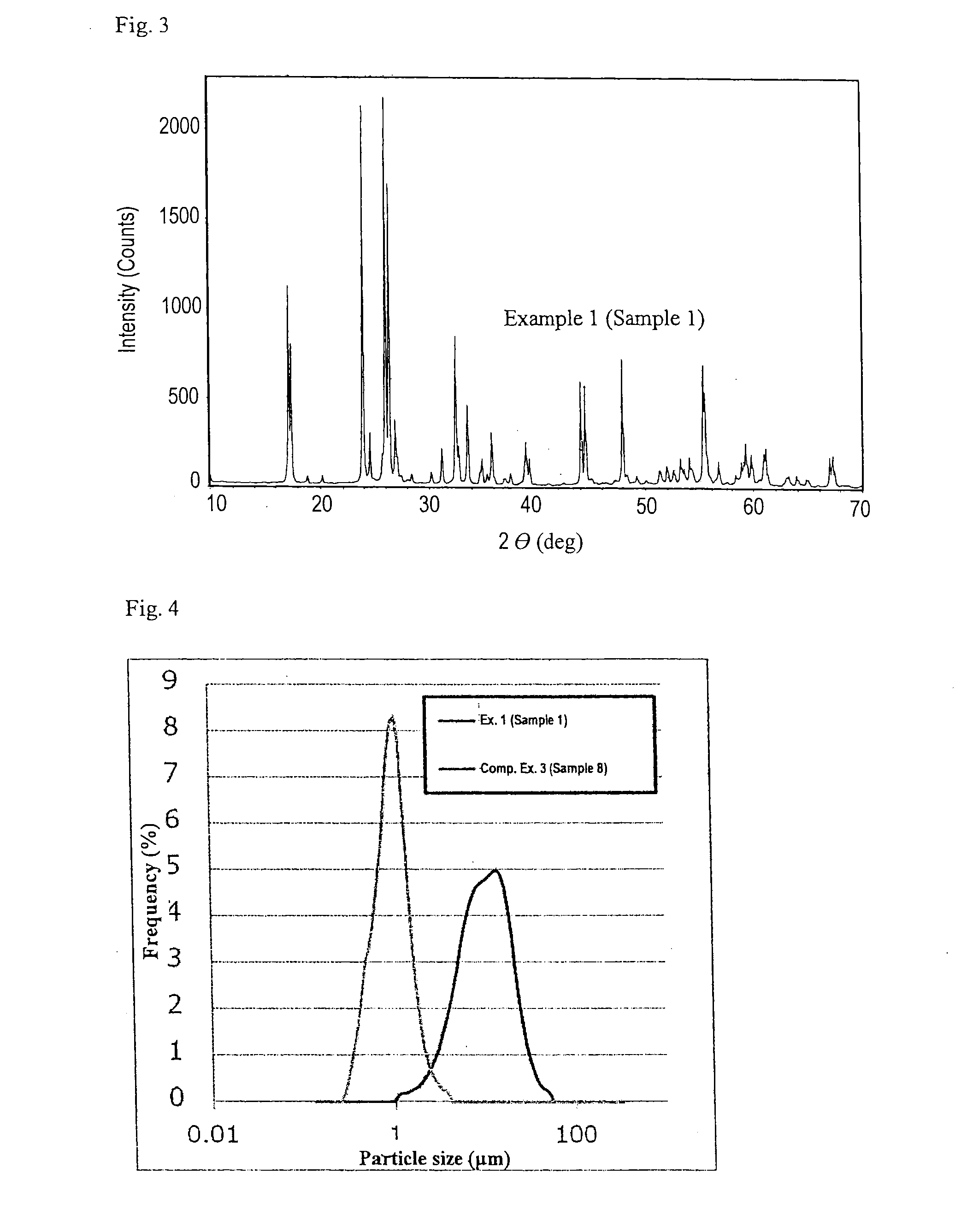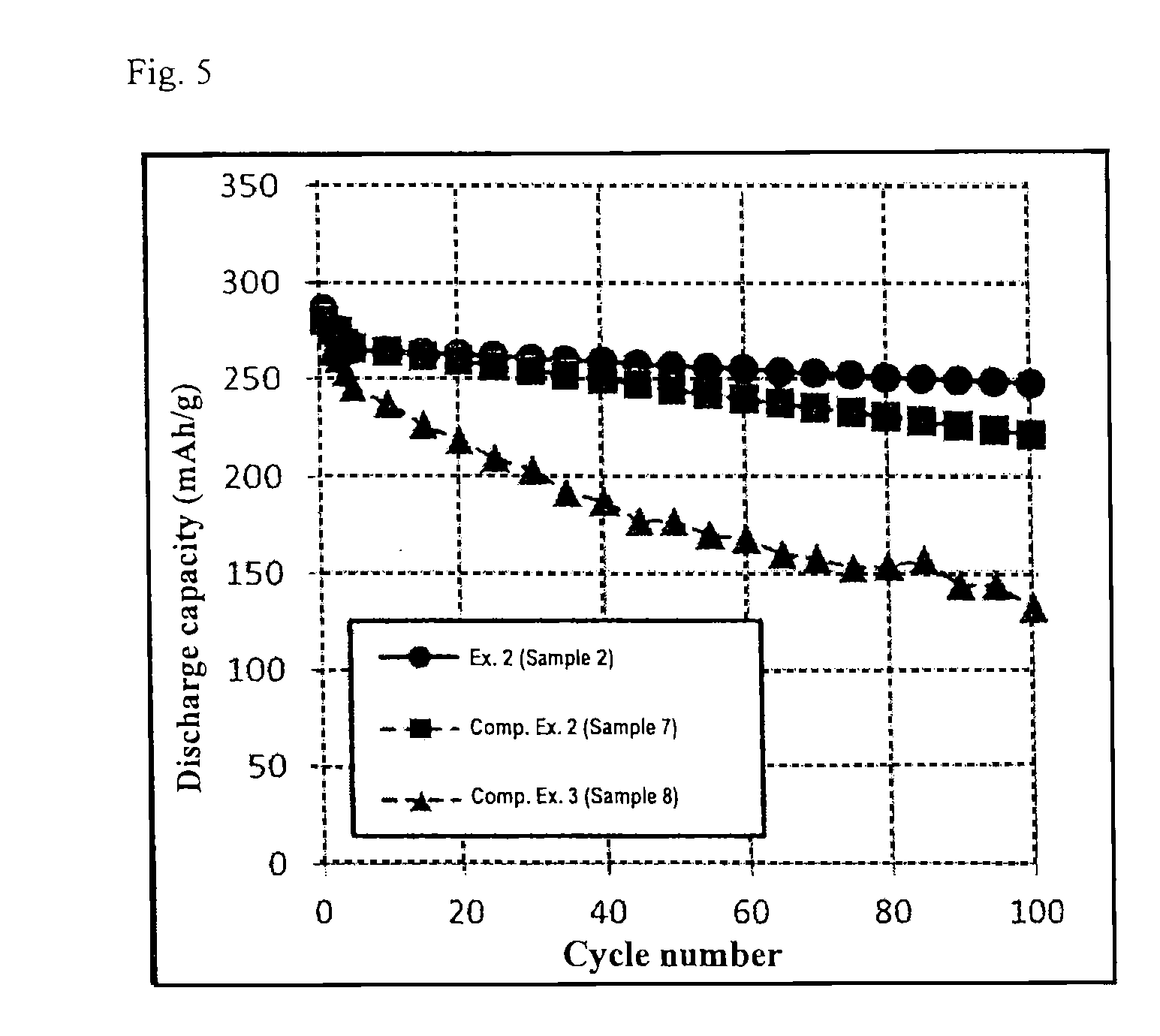Titanium-niobium composite oxide-based electrode active material and lithium secondary battery using the same
a technology of lithium secondary battery and active material, which is applied in the direction of niobium compounds, cell components, electrochemical generators, etc., to achieve the effect of superior cycle capacity retention rate and high charge and discharge capacity
- Summary
- Abstract
- Description
- Claims
- Application Information
AI Technical Summary
Benefits of technology
Problems solved by technology
Method used
Image
Examples
example 1
[0049]Anatase-type titanium oxide powder and niobium hydroxide powder were weighed in a molar ratio of Ti:Nb=1:1.99, put into a vibration ball mill, and pulverized and mixed for 9 hours. This mixture was taken out of the ball mill and fired in a box-type electric furnace at 1100° C. for 12 hours. The fired product was pulverized with a hammer mill and then prepared into slurry, maltose powder was added in a proportion of 10 wt. % relative to the solid content of the slurry, and the resulting mixture was spray dried with a spray dryer. The powder obtained was put into a rotary electric furnace and heat treated under a non-oxidizing atmosphere at 700° C. for 3 hours to give Sample 1 that is titanium-niobium composite oxide particles coated with 2.2 wt. % of carbon.
[0050]The intensities of Nb and Ti in Sample 1 which was obtained above were measured with an X-ray fluorescence spectrometer (trade name: XRF-1700, manufactured by Shimadzu Corp.). The Nb / Ti molar ratio as calculated by an ...
example 2
[0053]The same procedures as in Example 1 were carried out to prepare Sample 2 that is titanium-niobium composite oxide particles coated with 2.1 wt. % of carbon, except that anatase-type titanium oxide powder and niobium oxide powder were weighed in a molar ratio of Ti:Nb=1:1.92. An analysis of Sample 2 that was conducted in the same manner as in Example 1 revealed that Sample 2 had a Nb / Ti molar ratio of 1.92, a crystallite size of 100 nm, a specific resistance (powder) of 85 Ω·cm, and an average secondary particle size of 12.5 μm. A coin battery using Sample 2 was prepared and its battery performance was evaluated, revealing that the battery had discharge capacities of 286 mAh / g, 266 mAh / g, and 246 mAh / g at the 1st cycle (0.2C), the 5th cycle (1C), and the 100th cycle (1C), respectively, as well as a discharge capacity retention rate of 92% after the 100th cycle relative to that at the 5th cycle, and a 10C / 0.2C retention rate of 59%.
example 3
[0054]The same procedures as in Example 1 were carried out to prepare Sample 3 that is titanium-niobium composite oxide particles coated with 2.1 wt. % of carbon, except that the final heat treatment was carried out under a non-oxidizing atmosphere at 650° C. for 3 hours. An analysis of Sample 3 that was conducted in the same manner as in Example 1 revealed that Sample 3 had a Nb / Ti molar ratio of 1.99, a crystallite size of 96 nm, a specific resistance (powder) of 1230 Ω·cm, and an average secondary particle size of 8.9 μm. A coin battery using Sample 3 was prepared and its battery performance was evaluated, revealing that the battery had discharge capacities of 284 mAh / g, 262 mAh / g, and 244 mAh / g at the 1st cycle (0.2C), the 5th cycle (1C), and the 100th cycle (1C), respectively, as well as a discharge capacity retention rate of 93% after the 100th cycle relative to that at the 5th cycle, and a 10C / 0.2C retention rate of 51%.
PUM
| Property | Measurement | Unit |
|---|---|---|
| crystallite size | aaaaa | aaaaa |
| particle size | aaaaa | aaaaa |
| molar ratio | aaaaa | aaaaa |
Abstract
Description
Claims
Application Information
 Login to View More
Login to View More - R&D
- Intellectual Property
- Life Sciences
- Materials
- Tech Scout
- Unparalleled Data Quality
- Higher Quality Content
- 60% Fewer Hallucinations
Browse by: Latest US Patents, China's latest patents, Technical Efficacy Thesaurus, Application Domain, Technology Topic, Popular Technical Reports.
© 2025 PatSnap. All rights reserved.Legal|Privacy policy|Modern Slavery Act Transparency Statement|Sitemap|About US| Contact US: help@patsnap.com



